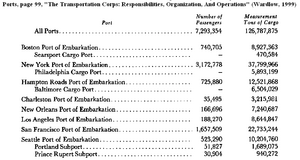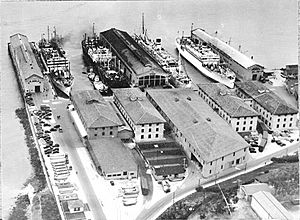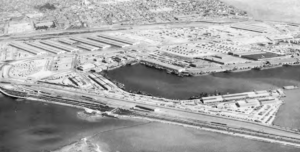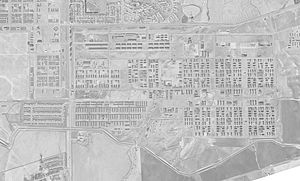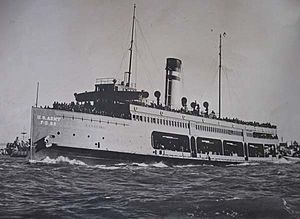San Francisco Port of Embarkation facts for kids
The San Francisco Port of Embarkation (SFPOE) was a very important United States Army base. It was in charge of moving soldiers and supplies across the Pacific Ocean during World War II. The SFPOE had many facilities around the San Francisco Bay area.
It started on May 6, 1932, and closed on October 1, 1955. At first, it was just a small terminal at Fort Mason. This was where Army ships for the Pacific were based. But this place was too small for a big war. So, in 1940, the port grew a lot. It added many new Army-owned and rented places. Some smaller ports in Seattle and Los Angeles were also part of it for a while. Later, these became their own separate commands.
Moving things by sea used to be the job of the Army Quartermaster Corps. But during World War II, the Army realized it needed a better system. So, in March 1942, they created a new Transportation Division. Then, in July, the U.S. Army Transportation Corps took over all surface transport. This included managing the ports of embarkation.
The San Francisco Port of Embarkation was the second largest port of its kind. The biggest was the New York Port of Embarkation (NYPOE). The New York port had been around since World War I and was a model for how these ports should work. An Army Port of Embarkation was much more than just a place for ships. It included Army camps, huge train and storage areas, and local transport networks. The old Fort Mason site was too small. So, new facilities were quickly added.
Eventually, the San Francisco Port of Embarkation included thirteen different locations. These were in addition to the main office and old port at Fort Mason. Rented piers and warehouses were not enough. So, by January 1941, a large Army facility was being built in Oakland. It opened in December 1941 as the Oakland sub-port. It later became the Oakland Army Base. To help prepare soldiers for travel, Camp Stoneman was built. Over one million soldiers passed through Camp Stoneman during World War II. Including the Korean War, 1.5 million troops used the camp. These places were all connected by roads and railways. The port also had a Water Division. This team managed, fixed, and changed the Army's ocean ships in the Pacific.
The SFPOE also managed how soldiers and cargo moved from where they started to where they ended up. Trains heading to the port only moved when the port commander ordered them to. Ships were under the port's control until they reached their destination. They even had port representatives on board. Troop ships had a Transport Commander. This person was in charge of all people on board, except the ship's crew. They represented the port commander. The SFPOE closed down on October 1, 1955.
How the Port Grew
The U.S. Army had used Fort Mason in San Francisco for its Pacific shipping for a long time. This port was the home base for Army Transport Service ships. These ships went to Alaska, Hawaii, the Philippines, and other Army posts in the Pacific. These areas were not heavily involved in World War I. So, the San Francisco port did not grow much then. But the New York Port of Embarkation (NYPOE) had expanded greatly during World War I. It was a good example of how a port should be organized. The NYPOE was reactivated as the U.S. got ready for World War II.
The Army realized that the small Fort Mason facility was not enough for a major war in the Pacific. So, they began a huge expansion. In early 1941, the Army bought land in Oakland and Seattle. The Oakland port facility was a big part of the San Francisco POE. It was 624.5 acres (2.5 km2) and was at the end of major train lines. Seattle became a sub-port in August 1941. This helped San Francisco by taking over its role in supplying Alaska. Seattle later became its own independent port in January 1942. A sub-port was also developed at Portland, Oregon. It was under SFPOE until November 1944. Los Angeles became a sub-port of San Francisco on January 24, 1942. It became independent on May 1, 1943.
The port's organization in 1945 was very detailed. It had many different groups, from 10 to 7,000 people in each. The Overseas Supply Division managed all outgoing shipments. It made sure orders followed rules and decided what to ship first. The Transportation Division organized movements within the port. This included getting things from arrival points to the docks. The Water Division managed, fixed, and converted ships. These ships ranged from small boats to large transport vessels.
Even after the Army lost its ocean transport role in 1950, the port kept working. Its ships were given to the Military Sea Transportation Service. But the port continued operations through the Korean War. It finally closed in October 1955.
What the Port Did
The commanders of the ports of embarkation had a lot of control. They knew how much space was available for soldiers and supplies. They also knew ship loading times and sailing details. Because of this, they controlled all movements from the starting points to the port. This included both soldiers and supplies. The port commanders gave detailed instructions on how to prepare soldiers before they left. The port had to make sure soldiers were fully trained and equipped before sailing.
The days right after the attack on Pearl Harbor showed how important this control was. San Francisco was overwhelmed with soldiers and cargo. More things arrived than could be shipped out. On one day, January 12, 1942, 3,208 loaded train cars arrived. This backlog threatened to stop the port completely. So, they had to stop new shipments for a while. The port's control became very good. Five months later, it could handle 2,500 freight cars per day.
The port's command also extended to soldiers and cargo on ships. This lasted until they reached their destination overseas. "Transport commanders" and "cargo security officers" were appointed by the port. They were on all troop and cargo ships under Army control. Soldiers on all ships, except U.S. Naval transports, stayed under the port commander's control. The Transport Commander was in charge of all passengers and cargo. But they did not operate the ship; that was the ship's captain's job. On large troop ships, the transport command had a permanent staff. This included people for administration, food, medical care, and chaplains. Cargo security officers were on ships that only carried Army cargo.
Port Facilities
The San Francisco POE included thirteen different locations in the San Francisco area. These were in addition to Fort Mason. The port used 20 piers with 43 berths for ocean ships. It had 2,867,000 square feet (266,350 m2) of warehouse space. It also had 1,984,000 square feet (184,320 m2) of transit shed space. Plus, there was 7,640,000 square feet (710,000 m2) of open space. The port could house 34,338 people in its staging areas. This included both traveling soldiers and staff.
Other facilities included piers at Alameda and the Richmond Parr Terminals. There was also an Air Force depot and the Emeryville Ordnance Shops. Hamilton Field was used for air shipments. The Presidio had an animal depot. The Stockton Piers and the Humboldt Bay Piers were also part of the port. The Emeryville Motor Depot was built to receive all vehicles in one place. Here, they were inspected, repaired if needed, and prepared for overseas shipment. This facility was very efficient. Between December 1941 and August 1945, it processed over 100,000 vehicles. It shipped out nearly 100,000 tanks, trucks, and other vehicles.
Troop staging areas were Army camps. These camps housed soldiers and gave them final training and equipment. Soldiers usually arrived by train. They were processed and given final training. This included how to act on ships and how to abandon ship. Their equipment was checked. Then, they were taken to the piers to board ships. Soon after the Pacific war began, many soldiers needed to be sent to the Philippines. So, the Presidio was used by the port as a staging area.
The staging camps were connected to the terminals and piers by water transport. Army harbor boats made regular trips. But the main way soldiers traveled was by ferries. Famous excursion vessels that served Santa Catalina Island, the Catalina and Cabrillo, were used. Their Army names were FS-99 and FS-100. The Oakland-San Francisco ferry Yerba Buena, later called Ernie Pyle, also joined the fleet. The trip to piers in San Francisco took three to four hours.
The port's main staging area was Camp Stoneman at Pittsburg, California. It was the largest on the West Coast. It also had the Pacific Coast Transportation Corps Officer Training School. Two train lines served Pittsburg. The San Joaquin River also offered water access. More than a million soldiers passed through this camp. Including the Korean War, over 1.5 million troops were processed there. Processing took four to five days from arrival to departure. Late in the war, the SFPOE tried loading soldiers directly onto a Liberty ship at Camp Stoneman. But this did not work well because large ships had trouble navigating to the camp.
Fort McDowell on Angel Island was a staging area for soldiers without specific assignments. It also held prisoners of war. The camp's dining hall could seat 1,410 people at once. But it had to have three meal times for each meal. About 300,000 men passed through Fort McDowell. At the end of the war, returning soldiers were processed here. Then, they were sent to troop trains in Oakland and San Francisco.
When the war ended, the port's job changed. Its facilities became centers for sending soldiers home quickly. A record might have been set when twenty trains loaded in Oakland and two in San Francisco in one day.
Port Operations
During the war, the port moved a huge amount of people and cargo. It sent 1,657,509 passengers and 22,735,244 tons of cargo into the Pacific. This was two-thirds of all soldiers sent to the Pacific. It was also more than half of all Army cargo moved through West Coast ports. The most passengers were loaded in August 1945, with 93,986 people leaving.
The port did have some challenges, especially compared to New York. While its operations were often praised, different parts of the port sometimes worked too independently. It also faced a unique problem compared to East Coast ports. Those ports shipped to well-developed Atlantic ports that were much closer. The Pacific ports, however, were often small, undeveloped, or very basic.
Closing the Port
On October 1, 1955, the San Francisco Port of Embarkation was closed. A new command, the Pacific Transportation Terminal Command, was set up at Fort Mason. It took over responsibility for all Army terminals and related tasks on the Pacific coasts of North and South America.



